Key takeaways:
- Coalition building thrives on trust, shared values, and effective communication, allowing diverse groups to unite for common goals.
- Political movements amplify marginalized voices, fostering solidarity and driving policy changes that address systemic issues.
- Historical examples, such as the Women’s Suffrage Movement and the Rainbow Coalition, demonstrate the power of united efforts against oppression.
- Key strategies for successful coalitions include establishing common ground, maintaining transparency, and celebrating small victories to build commitment and morale.
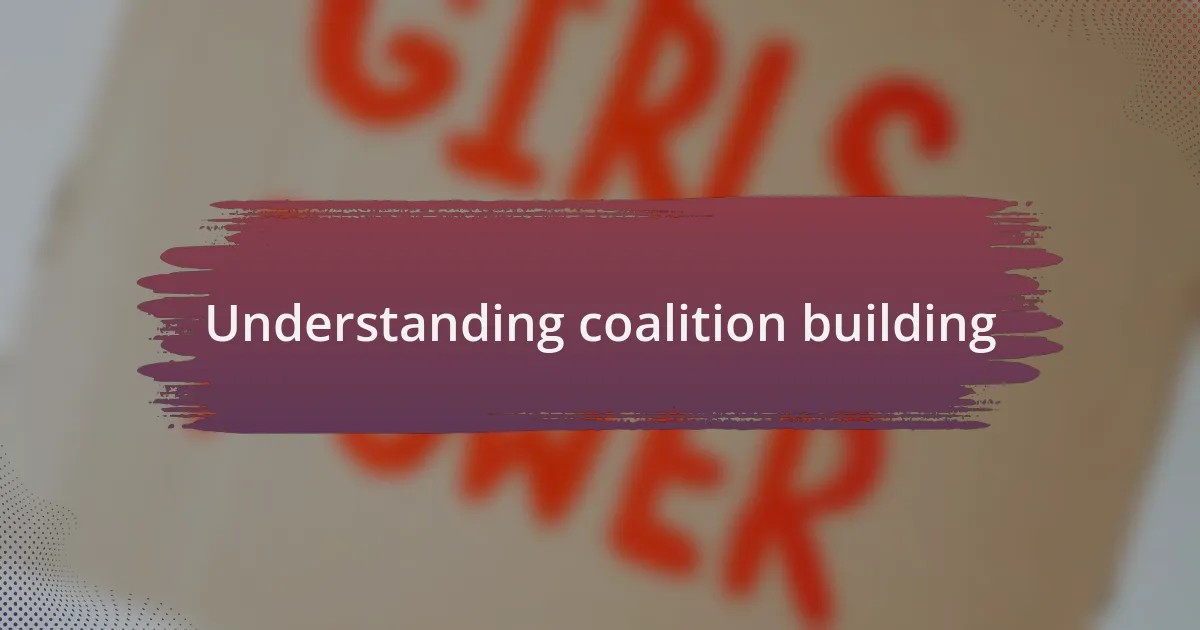
Understanding coalition building
Coalition building is fundamentally about creating alliances among diverse groups to tackle common goals. I recall a time when I witnessed a group of activists unite – it was incredible to see how different backgrounds and perspectives formed a powerful collective voice. It made me wonder how many opportunities lie in connecting with those who share even a sliver of our vision.
The emotional dynamics of coalition building cannot be overstated; it’s about trust and shared values. When I participated in a coalition, we spent hours discussing our various motivations and fears, which helped strengthen our bond. Have you ever engaged in a conversation where someone’s passion reignited your own? That’s the magic of bringing together individuals who may differ but share a commitment to change.
Understanding coalition building also involves recognizing the importance of communication and negotiation. I remember a particularly tense meeting where conflicting opinions clashed, but through respectful dialogue, we managed to find a common ground. What if we embraced our differences as opportunities, rather than obstacles? This mindset can transform the coalition-building process, leading to richer, more effective partnerships.
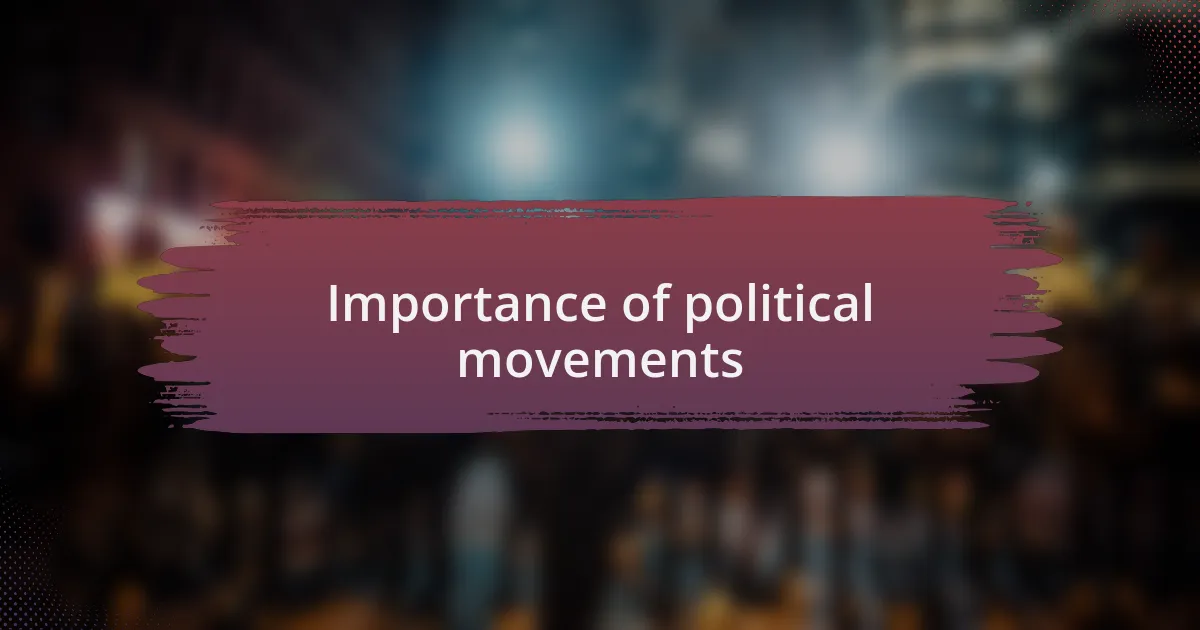
Importance of political movements
Political movements play a crucial role in shaping society. I’ve seen how grassroots efforts can amplify the voices of marginalized communities, creating a ripple effect that leads to meaningful change. When I participated in a movement advocating for environmental justice, the collective energy was palpable—it felt like we were part of something larger than ourselves.
The beauty of political movements lies in their ability to foster solidarity. I remember attending a rally where individuals from various backgrounds came together, all driven by a shared purpose. It illuminated for me how movements serve as platforms for diverse experiences, forging connections that often transcend our differences. Have you ever felt part of something truly transformative? That’s what happens when people unite for a common cause.
Moreover, political movements are essential for driving policy changes. They act as a catalyst for reforms that address deep-rooted issues. Reflecting on my experiences, I realize that the pressure we exert can indeed influence decisions at higher levels. It makes me wonder how much more impactful our collective action could be if we recognized the power we hold.
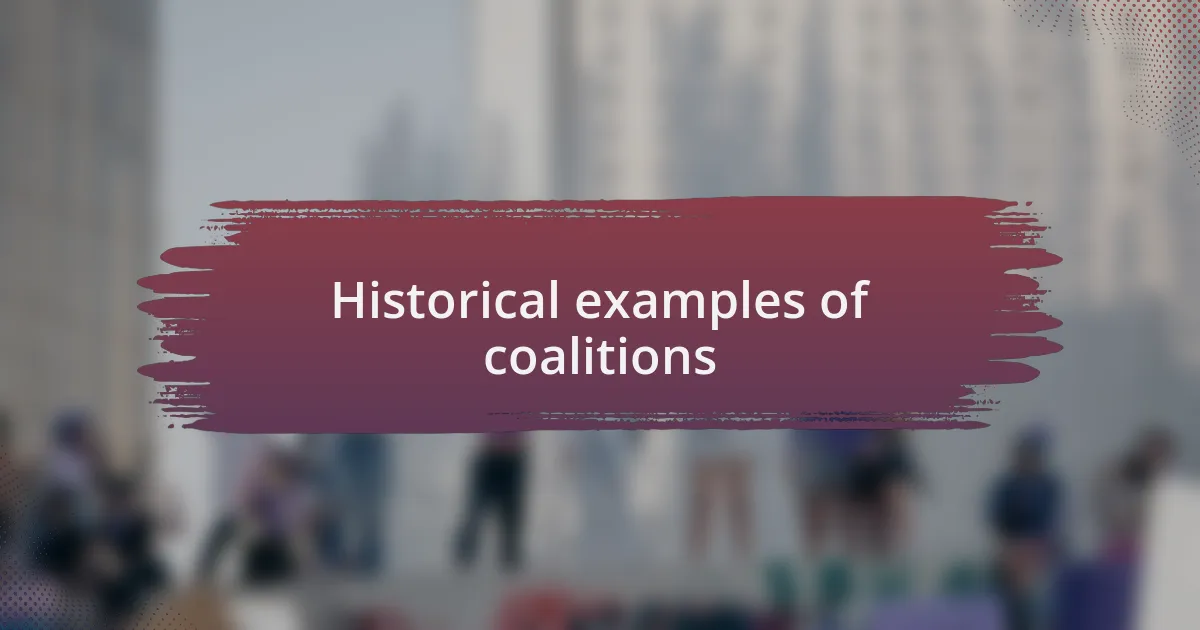
Historical examples of coalitions
Historical coalitions offer fascinating insights into the power of united efforts. For instance, during the early 20th century, the Women’s Suffrage Movement brought together diverse groups—suffragettes, labor organizations, and even some faith-based communities—all rallying for a single goal: women’s right to vote. I often wonder how exhilarating it must have felt for those women to see their collective voices gain strength over the years, culminating in the 19th Amendment in 1920.
Another poignant example is the Rainbow Coalition formed by activist Fred Hampton in the late 1960s. It brought together Black Panthers, white working-class activists, and Latino communities, all fighting against systemic inequalities. Their approach illustrated an inspiring vision of cross-racial solidarity. Hearing stories of how they organized joint breakfast programs makes me realize just how impactful coalitions can be, transcending barriers and showcasing a united front against oppression.
Moreover, I often reflect on the New Deal Coalition of the 1930s, which united various groups, including labor unions, urban intellectuals, and southern whites, to support Franklin D. Roosevelt’s policies. This coalition fundamentally reshaped American politics by aligning different interests toward common goals, like social welfare and economic recovery. It strikes me that, despite the challenges in merging diverse ideologies, the essence of coalition-building remains vital in the pursuit of social progress.
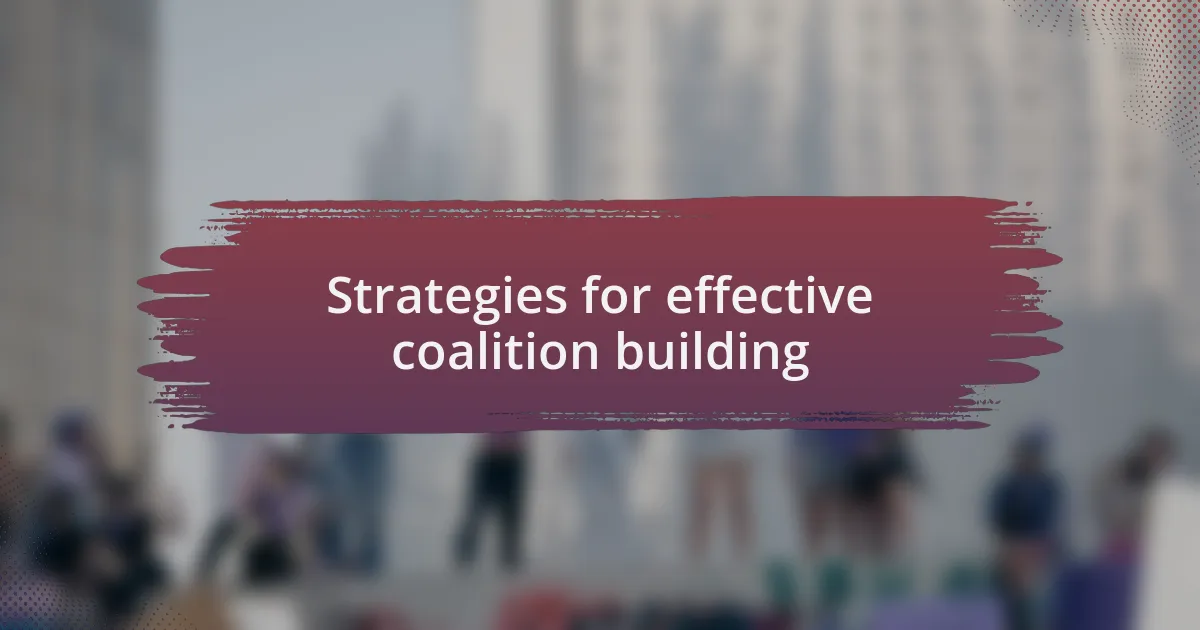
Strategies for effective coalition building
When it comes to effective coalition building, one of the strategies that resonates with me is the importance of establishing common ground among diverse groups. I remember a workshop I attended where facilitators emphasized the power of shared values. By focusing on what unites rather than what divides, coalition members can create a strong foundation that motivates collective action. It’s a reminder that inclusivity helps in not just gathering supporters but also in fostering trust among partners.
Another crucial aspect is effective communication. I’ve seen how regular check-ins, whether through meetings or online platforms, can help maintain momentum in a coalition. In my experience, sharing updates and addressing concerns openly makes everyone feel involved and valued. It’s surprising how transparency can transform the dynamics within a group, making it easier to navigate complexities and keep everyone aligned on goals.
Lastly, I believe that celebrating small victories is essential. I recall a coalition I was part of that took time to acknowledge our achievements, no matter how minor. It cultivated an atmosphere of encouragement and optimism, reinforcing our commitment to broader objectives. Have you ever noticed how much a simple recognition can uplift morale? In coalition building, these celebrations create a sense of belonging and drive, motivating members to continue working towards their shared goals.
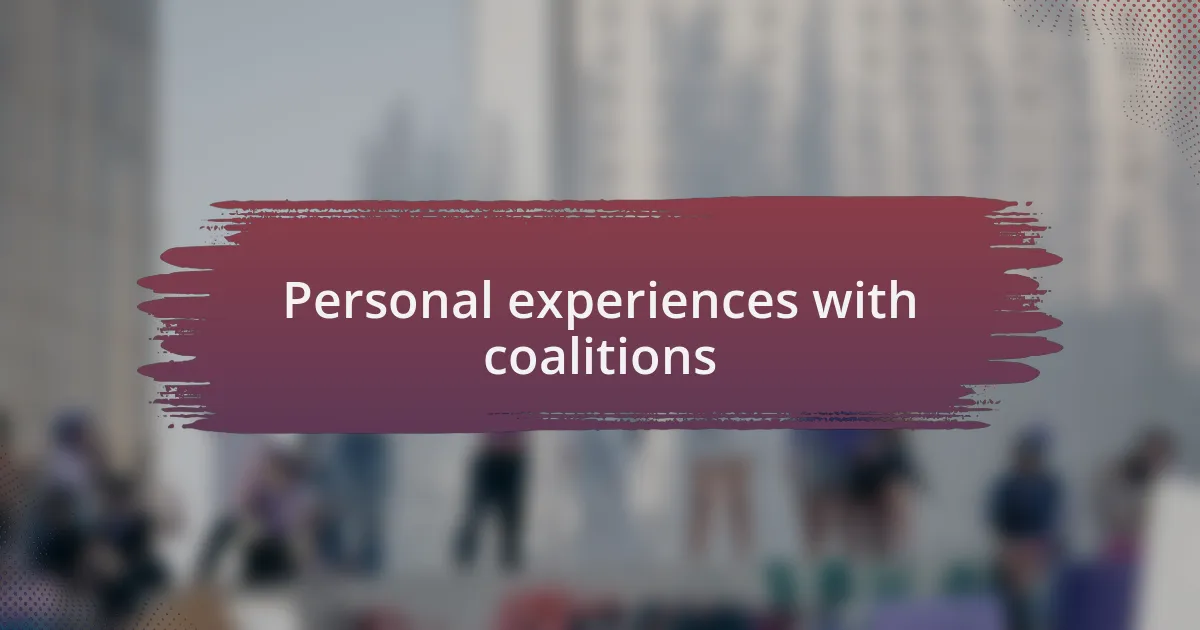
Personal experiences with coalitions
Working within coalitions has often been a rollercoaster of emotions for me. I remember joining a grassroots initiative where individuals came together from vastly different backgrounds. Initially, conversations felt strained, like trying to piece together a puzzle with missing parts. Yet, over time, shared moments of vulnerability, like discussing our own struggles and victories, built unexpected friendships. Isn’t it fascinating how overcoming initial awkwardness can lead to genuine connections?
I’ve also been part of coalitions that faced significant challenges, and I’ll never forget a particular instance of conflict during a planning session. Disagreements flared up, and I felt the tension in the room. It was a turning point when we decided to embrace those conflicts as opportunities for growth rather than setbacks. By openly discussing our differences, we ended up with innovative solutions that none of us had anticipated. Have you experienced a moment like that—a point where disagreement spurred creativity?
Celebrating our progress was something I learned to value deeply through my experiences. I think back to a project where we achieved a small milestone, and instead of moving on, we took the time to reflect and appreciate what we had accomplished together. The joy in that room was palpable! It struck me then how vital these celebrations were—it wasn’t just about the achievement, but also about reinforcing our bonds and commitment to our shared mission. Isn’t it rewarding to pause and reflect on how far we’ve come, together?
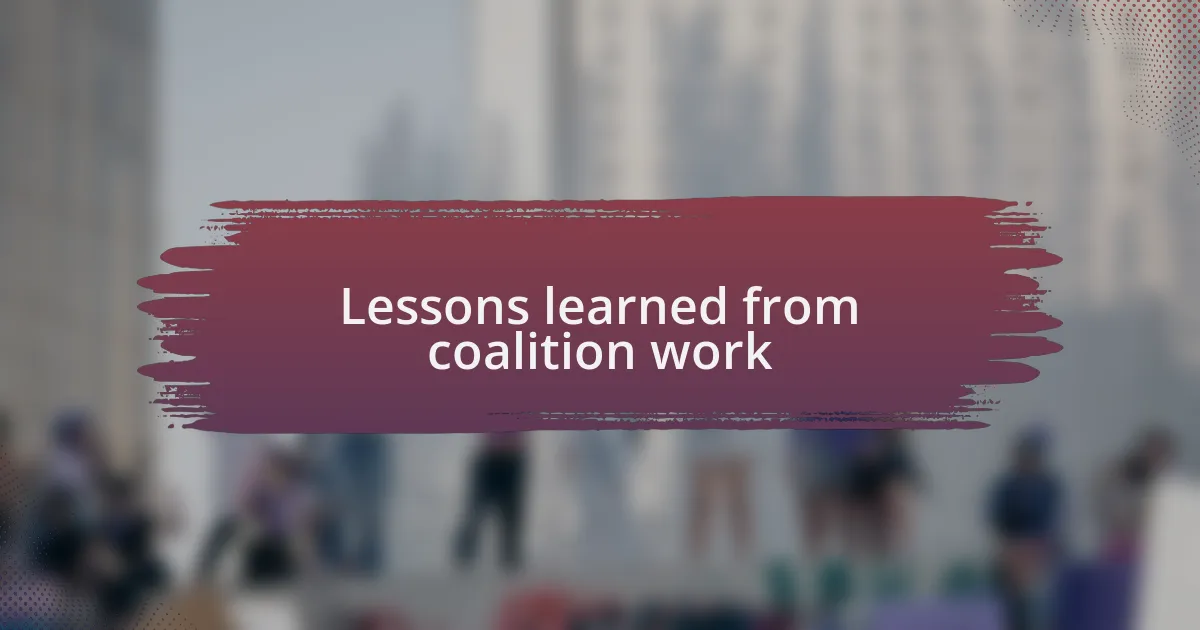
Lessons learned from coalition work
Engaging in coalition work taught me the importance of transparency. There was a particular project where we struggled with accountability; it felt like we were all operating in silos. After implementing regular check-ins, the whole dynamic shifted. Suddenly, it felt like we were in this together. Have you ever noticed how sharing updates can foster a sense of unity among team members?
Another lesson that resonated with me was the value of active listening. I remember a meeting where one member’s idea initially seemed off-track, yet when we truly listened, it sparked a new direction for our campaign. It made me realize that every voice holds potential. Isn’t it interesting how creating space for differing perspectives can lead to unexpected breakthroughs?
One of my most profound takeaways has been recognizing the necessity of adaptability. I recall a coalition project that had to pivot dramatically due to unforeseen circumstances. Initially, I felt anxious about the changes, but embracing flexibility allowed us to not only survive but thrive. Why do we often resist such shifts when they can lead to growth? Adapting to change can be the very key to success in coalition work.